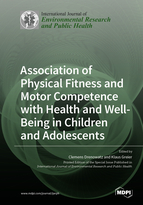Association of Physical Fitness and Motor Competence with Health and Well-Being in Children and Adolescents
A special issue of International Journal of Environmental Research and Public Health (ISSN 1660-4601). This special issue belongs to the section "Sport and Health".
Deadline for manuscript submissions: closed (31 October 2022) | Viewed by 25635
Special Issue Editors
Interests: sports nutrition; physical fitness; body composition; motor competence; physical activity; weight management; exercise
Special Issues, Collections and Topics in MDPI journals
Interests: diet; exercise science; physical fitness; motor learning; health promotion; physical education; strength and conditioning in youth
Special Issues, Collections and Topics in MDPI journals
Special Issue Information
Dear colleague,
Available research has indicated a decline in physical fitness and motor competence over the last several decades. Movement restrictions and policies that have emphasized social distancing, due to the recent COVID-19 pandemic, may have further increased the prevalence of youth with insufficient physical fitness and motor competence. As physical fitness and motor competence are critical contributors to an active and healthy lifestyle, it is important to re-emphasize their role in the general health and development of children and adolescents and, accordingly, future public health. Particularly with the re-opening of schools, sports clubs and public parks, the promotion of activities that enhance physical fitness and motor competence in children and adolescents is warranted.
This Special Issue aims to highlight the importance of physical fitness and motor competence for the health and well-being of children and adolescents, by providing an interdisciplinary platform for research addressing this topic. Manuscripts for consideration in this Special Issue can either describe original research or review the scientific literature. In addition, we welcome manuscripts that discuss theoretical models informing the design of interventions that target physical fitness and motor competence in children and adolescents, in order to increase future public health.
Potential topics may include, but are not limited to:
- Cross-sectional and longitudinal association of physical fitness and motor competence with various health outcomes (e.g., physical activity, body composition, cardio-metabolic health, mental health) during childhood and adolescence
- Environmental, socio-cultural and biological correlates of motor development and physical fitness
- Influence of COVID-19 policies on physical fitness and motor competence in children and adolescents
- Health promotion strategies targeting fitness- and motor competence in youth
- Association of motor competence and physical fitness at young ages with lifestyle habits later in life
- Measurement of motor competence and physical fitness from infancy through adolescence
Prof. Dr. Clemens Drenowatz
Prof. Dr. Klaus Greier
Guest Editors
Manuscript Submission Information
Manuscripts should be submitted online at www.mdpi.com by registering and logging in to this website. Once you are registered, click here to go to the submission form. Manuscripts can be submitted until the deadline. All submissions that pass pre-check are peer-reviewed. Accepted papers will be published continuously in the journal (as soon as accepted) and will be listed together on the special issue website. Research articles, review articles as well as short communications are invited. For planned papers, a title and short abstract (about 100 words) can be sent to the Editorial Office for announcement on this website.
Submitted manuscripts should not have been published previously, nor be under consideration for publication elsewhere (except conference proceedings papers). All manuscripts are thoroughly refereed through a single-blind peer-review process. A guide for authors and other relevant information for submission of manuscripts is available on the Instructions for Authors page. International Journal of Environmental Research and Public Health is an international peer-reviewed open access monthly journal published by MDPI.
Please visit the Instructions for Authors page before submitting a manuscript. The Article Processing Charge (APC) for publication in this open access journal is 2500 CHF (Swiss Francs). Submitted papers should be well formatted and use good English. Authors may use MDPI's English editing service prior to publication or during author revisions.
Keywords
- motor development
- motor skills
- cardiorespiratory endurance
- muscular strength
- body composition
- adiposity
- physical activity
- chronic disease risk
- mental health
- health promotion







